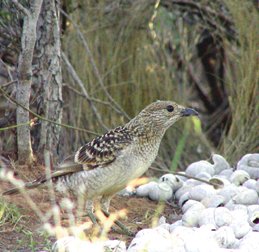When male spotted bowerbirds collect sticks and other doodads to wow females, these natural interior decorators don’t search for the rare showpiece, according to a new study.

Biologists have wondered whether male bowerbirds try to show off rare or costly treasures, says Joah R. Madden of the University of Cambridge in England. However, in recent tests of male preference in ornaments and their availability, no fancy tastes showed up, he and Andrew Balmford of University of Sheffield in England report in an upcoming Behavioral Ecology and Sociobiology. Items most appealing to females in earlier tests also turned out to be commonplace.
Among bowerbirds, which are native to the South Pacific, males stake out and decorate courting spots, and females shop among the local displays. In the spotted bowerbird (Chlamydera maculata) of Australia, males build two parallel walls of sticks that females can enter. Males strew the surroundings with shells, berries, twigs, and other knickknacks. When a female stops by, the male breaks into a song-and-dance routine.
Bowerbird lore includes tales of rare ornaments. A 1990 report, for example, said Archbold’s bowerbirds decorate with plumes from a bird of paradise species that molts only two of the big feathers a year.
To systematically check decor rarity, Madden and Balmford focused on 121 kinds of ornaments that spotted bowerbirds used in three areas of Queensland. The researchers sampled the areas to see how frequently each potential decoration turned up.
Madden had already shown that, among a bower’s adornments, many little green berries from a Solanum ellipticum bush best predict courtship success. Yet these berries ranked within the 11 most common decorations in the new survey.
Many bower decorations, such as metal tags, didn’t show up in the sampling. Yet Madden and Balmford found no correlation between such rarity and an item’s power to predict successful mating, as determined in the previous work. When offered sets of objects to use as ornaments, the male bowerbirds showed no preference for novelty.
Neither difficulty of collecting items nor the need to refresh the display gave any clue to effectiveness of a decoration. Solanum berries, for example, aren’t particularly heavy compared with other ornaments, and among five decorative fruits, the berries tied for first in holding their looks.
A long-time bowerbird researcher, Gerald Borgia of the University of Maryland in College Park, acknowledges that flirtation signals don’t have to be costly but questions Madden and Balmford’s analysis. “They are trying to assert a negative, which is difficult,” he says. He says he would like more analysis of such factors as color preferences.
Gail Patricelli of Cornell University says of the new study, “This is interesting, as a contrast to what satin bowerbirds do.” They favor rare, blue ornaments, and males steal them from each other, so a blue-adorned bower signals that its holder has been enterprising and tough, she says.
Among spotted bowerbirds, bower decorations signal social standing, says Madden. The number of green berries reflects the rank of a male; otherwise, neighboring males attack.
****************
If you have a comment on this article that you would like considered for publication in Science News, send it to editors@sciencenews.org. Please include your name and location.






